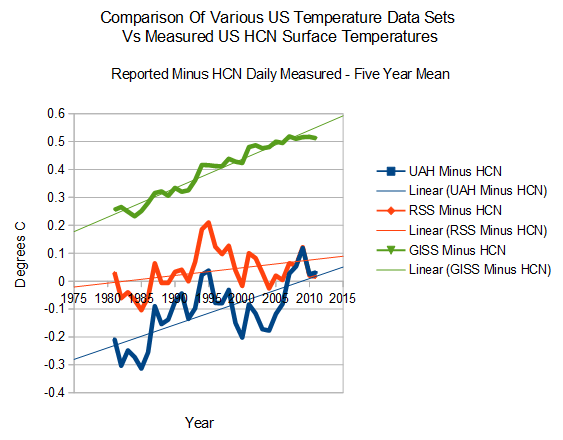The graph below compares UAH, RSS and GISS US temperatures with the actual measured US HCN stations. UAH and GISS both have a huge warming bias, while RSS is close to the measured daily temperature data. The small difference between RSS and HCN is probably due to the fact that my HCN calculations are not gridded.
My conclusion is that RSS is the only credible data set, and all the others have a spurious warming bias.
It doesn’t matter how beautiful your theory is, it doesn’t matter how smart you are. If it doesn’t agree with experiment, it’s wrong.
– Richard P. Feynman



You can trust well-paid government scientists to honor truth more than money.
That is why the growth in scientific integrity correlates with increases in government research funds.
On the UN-IPCC CAGW generally –
It doesn’t matter how beautiful your theory is, it doesn’t matter how smart you are. If it doesn’t agree with experiment, it’s wrong.
– Richard P. Feynman
Note to the UN – If it ain’t warming you’re wrong!
Roy Spenser’s post
http://www.drroyspencer.com/2014/10/why-2014-wont-be-the-warmest-year-on-record/
Therein, he has a comparison chart of RSS and UAH global average temperature through September of this year. A few paragraphs below the chart he begins “And, it is of continuing amusement to us . . .”
The “bolding” above is me indicating that these are not the same data shown in your chart.
I think I made it pretty clear that I am referring to US temperatures. Whatever you are trying to say doesn’t impact this discussion one way or another.
I was trying to say, read why Roy thinks something is funny.
The RSS probably reflects stations away from the UHI effect.
Did you mean
RSS “properly” reflects stations away from UHI effects? 😉
I noticed a similar thing a few years ago, namely that the UAH trend over US 48 was three times higher than the rural trend. I pointed that out at Roy Spencer’s blog. A couple of days later he came up with an analysis claiming that HAdCrut adjustments for the USA were ok, so the UAH and HAdcrut were consistent and don’t pay attention to the rural data.
I remember Dr. Spencer saying that his MSU readings are calibrated to dropsondes directly. I want to say that they are calibrated to surface temps indirectly. Since the MSUs suffer drift and the satellites suffer drift, and the dropsondes suffer drift, and the surface stations suffer drift, some kind of ground truth must be used.
All of these sets have issues, but I trust the MSU ones for at least they do get cross-validated and I see they do try to do error analysis and propagation.
SG, is there enough data to start bringing the USCRN into the picture as well. Nearly 10 years?
Thy got their fancy satellites to give them worldwide temperature data, and now I read that some NOAA scientists think the satellite data is off by as much as 30 percent, on the low side obviously.